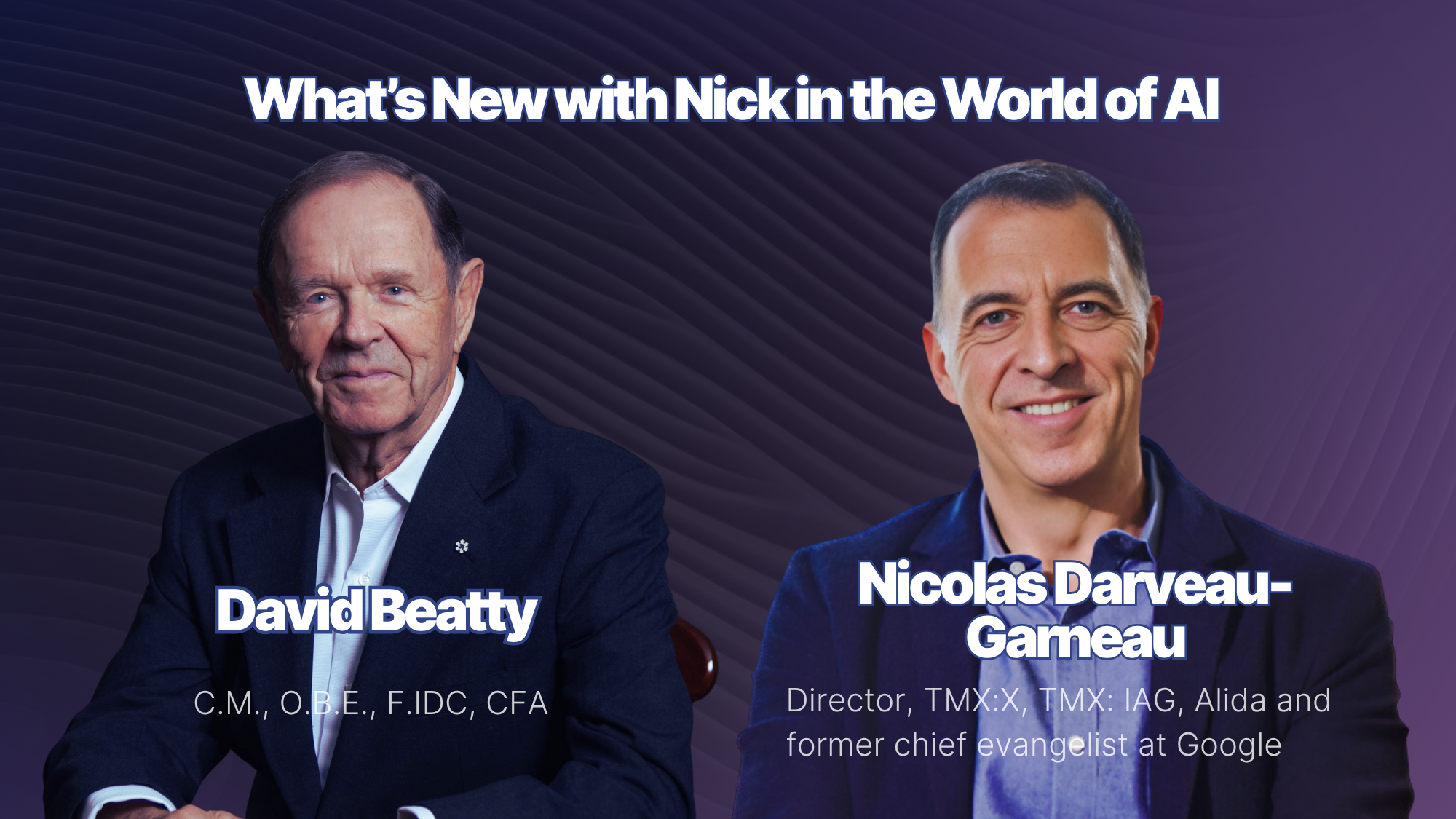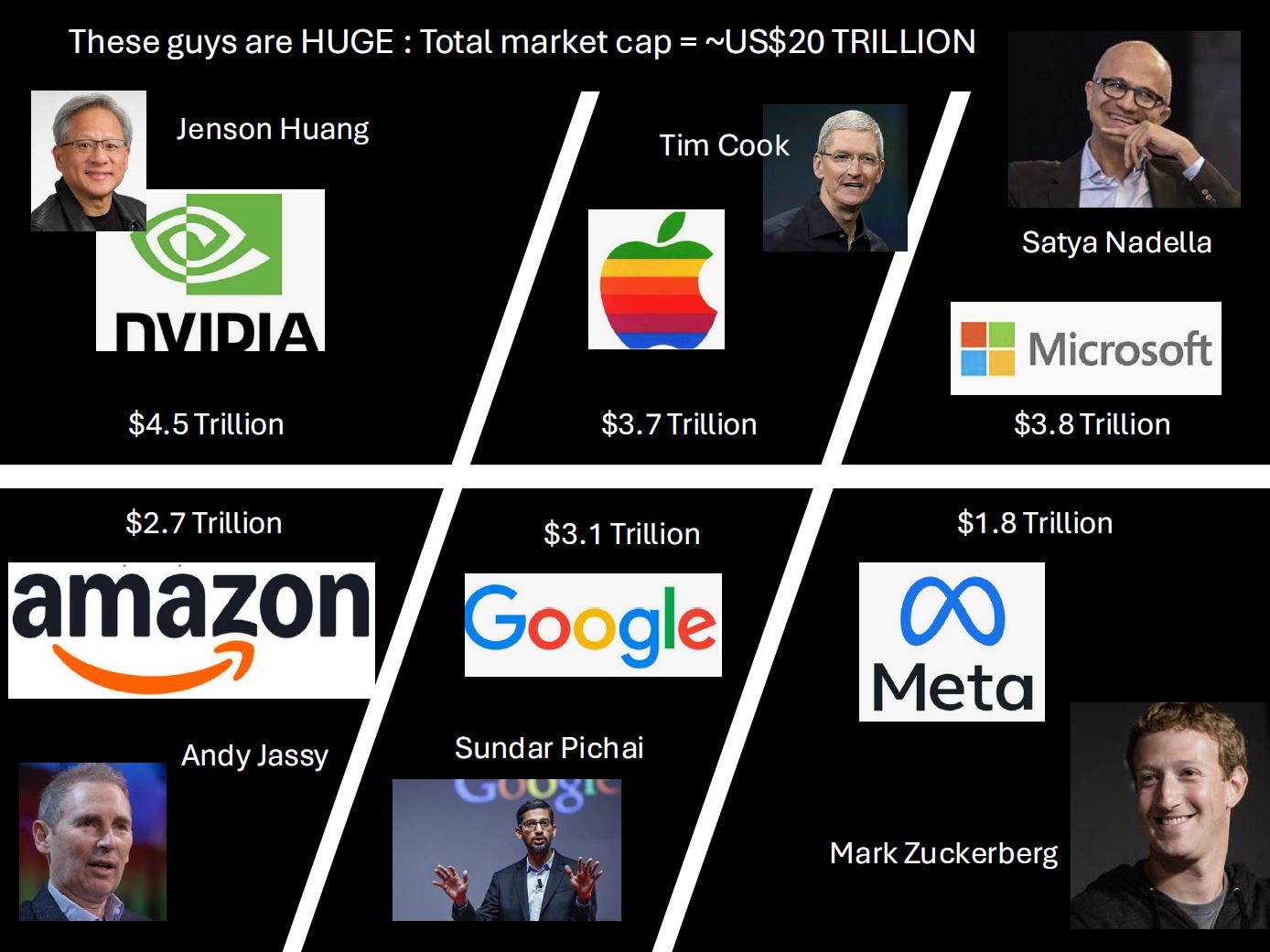The Amazing Pace of Change in AI with Nick Darveau-Garneau, October 2025

This recap is from October's AITsunami series by David Beatty and Nick Darveau-Garneau, which monitors important AI developments and their effects on corporate directors and the businesses they oversee.
The Titans Leading the Charge
The six largest tech companies control nearly $20 trillion in market value. They're generating $500 billion quarterly in sales and they're about to reshape computing as we know it. I am convinced that we are living through a historical change.

These companies aren't just sitting on massive valuations. Their Q1 2025 sales totaled over $500 billion, with a combined free cash flow of $122.6 billion annually. That's serious money being reinvested into AI infrastructure and development.
The Investment Frenzy

Nvidia alone completed 49 AI startup investments in 2024, matching Google's aggressive pace. Microsoft added 24 deals, while Amazon contributed 20. This isn't scattered investment. Rather, it's strategic positioning across three key areas:
- Core AI Infrastructure: Building the physical backbone
- Cloud Services: Providing platforms for AI deployment
- Model Development: Creating specialized AI applications
The venture capital world has joined the party, too. Q3 2025 saw $11 billion in new AI deals across 795 companies. With $2 trillion in dry powder waiting to be deployed, we can expect this pace to continue.
Physical Infrastructure at Unprecedented Scale
Microsoft and Meta each operate 485,000 Nvidia H100 chips, with Meta planning to expand to 600,000. OpenAI targets one million chips through its Stargate joint venture; a $500 billion commitment by 2029.
The physical footprint is staggering, to say the least:
- Amazon's new facility: 2.2 gigawatts of power (with 1 million gallons of water used daily)
- Meta's Louisiana center: 2 gigawatts
- OpenAI's Texas facility: 1.2 gigawatts
- UAE's ambitious project: 5 gigawatts (the world's largest)
McKinsey estimates $6.7 trillion in global data center investment through 2030, with capacity growing 3.5x between 2025 and 2030.
The AI Model Technology Acceleration

Training efficiency doubles every 5 months, compared to the conventional Moore's Law's 18-month doubling cycle. The latest Nvidia B200 chip packs 208 billion transistors, up from 80 billion in the H100 just two years ago.
Combined with algorithmic improvements doubling efficiency every 8 months, we're seeing compound gains that dwarf traditional computing progress. The result? AI systems today are literally one billion times more capable than a decade ago.
Inside AI's Practical Revolution
With our very own Nick Darveau-Garneau, Google’s former Chief Evangelist, here’s what's actually happening on the ground in AI deployment.
The Hallucination Problem Is Finally Cracking
ChatGPT-4 hallucinated about 20% of the time, essentially lying once every five sentences. ChatGPT-5, despite mixed reception, quietly reduced this to around 3%.
As Nick explained, "Once you get hallucinations below 0.1%, you can start removing humans from the loop. That's when you see not 15% productivity gains, but thousand-fold improvements."
Real-World Impact: Waymo's Breakthrough
San Francisco now has over 100 Waymo vehicles operating without drivers at any given time. After years of development with safety drivers, Google cracked the reliability code. The result? An explosion of self-driving technology that will become a multi-hundred-billion dollar industry within five years.
Verticalization: The Hidden Revolution
While ChatGPT grabs headlines, specialized AI models are quietly dominating specific industries:
- Harvey (Legal AI): $100 million run rate after 2.5 years, growing 100% annually
- Medical Diagnostics: AI accuracy now matches or exceeds specialized doctor teams
- Financial Services: ChatGPT recently acquired a vertical AI company for financial advice
These vertical models offer lower hallucination rates, 10× faster adoption than horizontal models, and 2–3× faster implementation overall.
The Cost-Performance Revolution
Performance improvements tell only half the story. Costs are plummeting 90% every 18 months. Combine thousand-fold performance gains over 5 years with dramatic cost reductions, and you get a 2.2 million times improvement in power-cost efficiency.
As Nick noted in our session: "Companies deploying AI today might see marginal or negative ROI but if you don't build the muscles now, and your competitors do, where will you be when the technology is 2.2 million times better in 5 years?"
Agentic AI: The Next Frontier
Agentic AI, systems that break down complex tasks and coordinate with other AIs, has reached a critical milestone. Anthropic developed a standard for agent communication that Google, Amazon, and OpenAI have all adopted.
The question looms: When did competitors ever agree on one standard this quickly?
The implications are profound. An AI planning David’s trip to Milan would automatically understand you need flights, hotels, activities, and possibly visas. It would then coordinate with specialized AIs to handle each component.
The Software Revolution: Two Years Away
Perhaps most significantly, AI is approaching the ability to write software independently. Current systems can reduce 20,000 lines of code to 300, with AI writing 90% accurately.
Nick pointed out that we're about two years away from AI writing 99.999% of code correctly. He added, "That means infinite software. Every idea becomes possible."
Marketing's Complete Transformation
Modern AI-driven marketing bears little resemblance to traditional approaches. In the past, marketers would create and test a single ad, target broad demographics, and wait months to gauge results. Today, thousands of ads are generated in real time, each personalized to individual viewers, with performance measured and ROI calculated instantly.
Leading insurance companies now use AI to:
- Generate personalized ads instantly
- Calculate each customer's lifetime value
- Adjust spending daily based on AI recommendations
- Guarantee positive ROI on advertising spend
"These companies don't have marketing budgets anymore," Nick revealed. "The AI decides spending every day."
Governance and Board Implications
Boards today face a profound transformation challenge, one that demands both vigilance and vision. On one hand, directors must ensure strong governance to prevent AI-related risks. On the other, they are expected to champion bold strategies that drive genuine transformation.
As Nick mentioned in our session, “You can’t just install AI and expect productivity gains. You have to rethink entire processes.”
That mindset shift was evident when he advised a mental health hospital whose executives asked how to make their operations more efficient with AI. He reframed the question entirely: “How can you use AI to deliver better mental health care at the lowest possible cost?”
For boards navigating this landscape, several principles stand out. Begin with low-risk use cases (such as internal training) before expanding to customer-facing applications. Maintain human oversight until AI systems demonstrate proven accuracy. Focus on transformation rather than mere optimization, reimagining processes instead of automating old ones.
And finally, plan for exponential change: envision a future where hallucinations are eliminated and software capabilities seem virtually limitless.
The Race You Can't Afford to Lose
The risk of doing nothing is the biggest risk. Companies seeing negative ROI today are building critical capabilities for tomorrow. Those waiting for perfect conditions will find themselves competing against organizations with years of AI experience when the technology reaches its inflection point.
The message is clear: The companies that master AI integration now, despite current limitations, will dominate when the technology delivers on its full promise. And based on current trajectories, that moment is closer than most realize.
